Ninja Gaiden is a media franchise based on action video games by Tecmo featuring the ninja Ryu Hayabusa as its protagonist. The series was originally known as Ninja Ryukenden in Japan. The word "gaiden" in the North American Ninja Gaiden title means "side story" in Japanese. The original arcade version, first two Nintendo Entertainment System games and Game Boy game were released as Shadow Warriors in PAL regions. As of 2008, the series has shipped over 7.7 million copies.

The House of the Dead is a 1996 horror-themed light-gun shooter arcade game developed by Sega AM1 and released by Sega. It is the first game in the House of the Dead series. Players assume the role of agents Thomas Rogan and "G" as they combat an army of undead experiments created by Dr. Curien, a mad scientist.
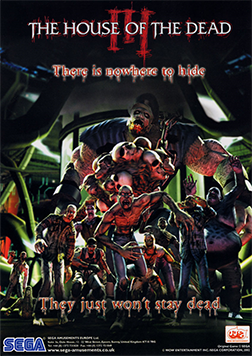
The House of the Dead III is a 2002 horror-themed light gun arcade game and the third installment of the House of the Dead series of video games, developed by Wow Entertainment and Sega. It was ported to the Xbox in 2003, Microsoft Windows in 2005, the Wii in 2008 in a compilation with The House of the Dead 2, and PlayStation 3 in 2012 with PlayStation Move support. The game was remade with typing controls as The Typing of the Dead 2 in 2008. The game continues the story of the previous games and introduces new gameplay concepts. The game's secondary protagonist is Lisa Rogan, daughter of Thomas Rogan and Sophie Richards.
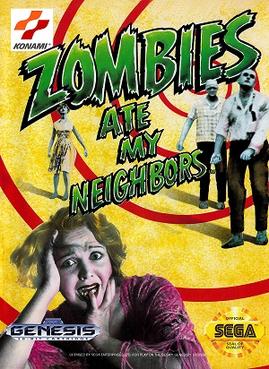
Zombies Ate My Neighbors also is a run and gun video game developed by LucasArts and published by Konami for the Super NES and Sega Genesis consoles in 1993.
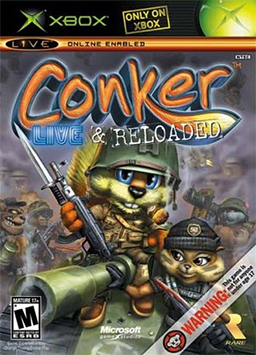
Conker: Live & Reloaded is a 2005 platform game developed by Rare and published by Microsoft Game Studios for the Xbox. It is a remake of the 2001 game Conker's Bad Fur Day for the Nintendo 64, with a new multiplayer mode using Xbox Live that is different from the original. Development started the moment Rare was bought by Microsoft in 2002. The game was made available as a part of Xbox One's backwards compatibility program on 17 April 2018.

Resident Evil is a 1996 survival horror game developed and published by Capcom for the PlayStation. It is the first game in Capcom's Resident Evil franchise. Set in the fictional Arklay mountain region in the Midwest, players control Chris Redfield and Jill Valentine, members of the elite task force S.T.A.R.S., who must escape a mansion infested with zombies and other monsters.

Dead Rising is a 2006 action-adventure game developed and published by Capcom. The game is the first entry in the Dead Rising series. The story follows photojournalist Frank West after he becomes trapped in a zombie infested shopping mall in the town of Willamette, Colorado. Frank must uncover the mystery behind the outbreak before a rescue helicopter arrives in three days to evacuate him. The game features multiple endings depending on the conditions met by the player.

Doom 64 is a 1997 first-person shooter video game developed and published by Midway Games for the Nintendo 64. It is the second spin-off in id Software's Doom series after Final Doom (1996), and the fourth game in the series overall. A remaster was developed by Nightdive Studios and published by Bethesda Softworks for Nintendo Switch, PlayStation 4, Windows, and Xbox One in March 2020, and for Stadia in May 2020.
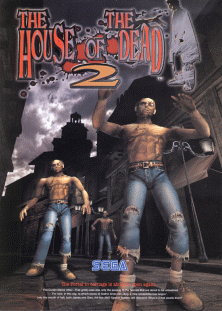
The House of the Dead 2 is a horror-themed light gun shooter arcade game and the second game in The House of the Dead series of video games. The direct sequel to The House of the Dead, it was developed by Sega for arcades on the Sega NAOMI board in November 1998, and it received several home ports, starting with the Dreamcast in 1999, Microsoft Windows in 2001, Xbox in 2002 as a bonus in The House of the Dead III and on Wii as part of the compilation The House of the Dead 2 & 3 Return. It would also serve as the basis for several spinoff games in the franchise, most notably The Typing of the Dead.

S.C.A.R.S. is a 1998 sci-fi themed futuristic racing video game developed by Vivid Image and published by Ubi Soft for PlayStation, Nintendo 64, and Microsoft Windows.

The Pinball of the Dead is a pinball video game developed by Sega's Wow Entertainment division and published by Sega. It was released for the Game Boy Advance in 2002 and 2003. Based on Sega's The House of the Dead series of light gun games, particularly The House of the Dead and The House of the Dead 2, the game contains three tables and includes a "Challenge" mode. Full-motion video sequences and audio samples from previous games were also added. The game was first announced during the 2001 Nintendo Space World. Composer Hitoshi Sakimoto was involved with making the game's music.

Nanostray 2 is a scrolling shooter video game for the Nintendo DS, and is the sequel to the original Nanostray. The game was released in 2008.

Call of Duty 4: Modern Warfare is a first-person shooter video game in the Call of Duty franchise, developed specifically for the Nintendo DS. It was released by Activision in November 2007. The game features many elements of gameplay typical to the series, including vehicular missions and the usage of iron sights.

Wild Guns is a 1994 space Western shooting gallery video game developed by Natsume for the Super Nintendo Entertainment System. Set in the Wild West with steampunk and sci-fi influences, the story follows Annie and her bounty hunter Clint, seeking revenge for the death of her family. The player controls either Annie or Clint sidestepping and jumping in the foreground while shooting down enemy robots in the background and dodging enemy bullets. These gameplay mechanics combine elements from third-person shooters and light gun games.
Light-gun shooter, also called light-gun game or simply gun game, is a shooter video game genre in which the primary design element is to simulate a shooting gallery by having the player aiming and discharging a gun-shaped controller at a screen. Light-gun shooters revolve around the protagonist shooting virtual targets, either antagonists or inanimate objects, and generally feature action or horror themes and some may employ a humorous, parodic treatment of these conventions. These games typically feature "on-rails" movement, which gives the player control only over aiming; the protagonist's other movements are determined by the game. Games featuring this device are sometimes termed "rail shooters", though this term is also applied to games of other genres in which "on-rails" movement is a feature. Some, particularly later, games give the player greater control over movement and in still others the protagonist does not move at all. On home computer conversions of light-gun shooters, mouse has been often an optional or non-optional replacement for a light gun.

Call of Duty: World at War is a first-person shooter video game in the Call of Duty franchise, released for the Nintendo DS. It was released by Activision, alongside the console versions of the game, in November 2008. The game takes place during World War II and features many elements of gameplay typical to the series, including vehicular missions and the usage of iron sights.
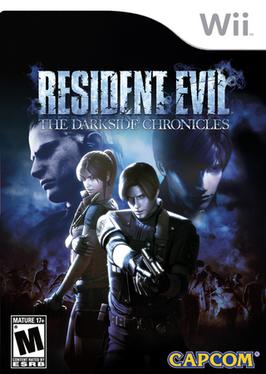
Resident Evil: The Darkside Chronicles is an on-rails light gun shooter video game for the Wii developed by Capcom and Cavia as part of the Resident Evil series. The game was released for the Wii on November 17, 2009, in North America. It serves as a prequel to Resident Evil 4, set 2 years before its events. It was released in Europe on November 27, 2009, bundled with the Wii Zapper accessory.

GoldenEye 007 is a 2010 first-person shooter video game developed by Eurocom and published by Activision for the Wii, with a handheld version for Nintendo DS developed by n-Space. It is a modern reimagining of the 1995 James Bond film GoldenEye as well as a remake of the 1997 video game of the same name, developed for the earlier Nintendo 64 console. The game was officially announced by Nintendo at their E3 2010 conference presentation. The game was released on 2 November 2010 in tandem with another James Bond game, Blood Stone, which was also released for the DS, but not the Wii. Nintendo, the publisher of the Nintendo 64 game, published the Wii version in Japan the following summer, where it remains Wii-exclusive. It was the fifth James Bond game developed by Eurocom and their second under Activision, after the PlayStation 2 version of 007: Quantum of Solace two years prior.

Resident Evil: The Mercenaries 3D is a third-person shooter video game developed by TOSE and published by Capcom for the Nintendo 3DS. It was released on June 2, 2011 in Japan, June 28, 2011 in North America, June 30, 2011 in Australia, and July 1, 2011 in Europe. The game was announced at the 2010 Nintendo conference in Japan. A combination of the "Mercenaries" minigames featured in Resident Evil 4 and 5, players must defeat as many enemies as possible within a set time limit.
















